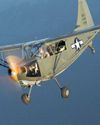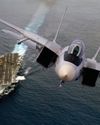Right Place, Right Time
Flight Journal
|2019 Special Issue: WWII Air War
How luck and fate allowed me to survive my missions.

Christophe and Isabelle Laniece live in Grenoble, France, and they are both physicians. They also happen to be world-class sailors. In August 2006, they drove to Marseilles with their son, Cami, and daughters Elsa and Charlotte, and there they embarked on a 10-day cruise on the Mediterranean Sea that would cover 1,200 miles—on a catamaran! Jane, Charlotte’s pen pal from Philadelphia, was with them.
On the first leg of their odyssey, the twin hulls of their sleek vessel carried them east past Toulon to the tip of the island of Corsica and then south along the coast. Charlotte’s friend, Jane, is my granddaughter, and when Jane told me about her adventure, it occurred to me that they had sailed directly over some of our U.S. aircraft that had ditched in the Mediterranean during WW II. Thierry Willaey lives in Provence. He belongs to a SCUBA club and combines his love of diving with his interest in those underwater relics from WW II. One of his group’s discoveries was the remains of a Martin B-26 that had ditched 50 meters off the coast of Corsica in water just 13 meters deep. Initially, they had identified it as a plane from the 17th BG, and their findings, including the N number on the plane’s vertical stabilizer, were published on the Internet. Franz Reisdorf, historian for our 320th Bomb Group, saw the article. “The ‘N’ number was 43-34234,” Franz said, “and it stuck in my mind. I finally looked through my slides, and there it was: N 43-34234, on the tail of Lt. Robert Dinwiddie’s aircraft that got hit on August 22, 1944, over Vergato, Italy.” The French were pleased to get this positive identification. Franz was excited when he called to tell me about the find, and it got me thinking back to those incredible days more than 60 years ago, when I was a 20-year-old pilot flying on that mission.
Bu hikaye Flight Journal dergisinin 2019 Special Issue: WWII Air War baskısından alınmıştır.
Binlerce özenle seçilmiş premium hikayeye ve 9.000'den fazla dergi ve gazeteye erişmek için Magzter GOLD'a abone olun.
Zaten abone misiniz? Oturum aç
Flight Journal'den DAHA FAZLA HİKAYE

Flight Journal
ELLIPTICAL ELEGANCE
Flying and evaluating the Seafire Mark III
4 mins
November - December 2025

Flight Journal
IRON DOG
Fighting the Pacific and the P-39 at the same time
14 mins
November - December 2025

Flight Journal
Fighter Pilots: A Warrior Clan
TAKE A HARD LOOK at the two young men in these photos. Do they look as if they were bent on killing one another? On the left we have a young, unknown enlisted Japanese pilot standing in front of a Nakajima Ki-27 \"Nate,\" one of Japan's earliest monoplanes that led to the much vaunted Zero.
3 mins
November - December 2025

Flight Journal
KEN WALSH THE FIRST CORSAIR ACE
Medal of Honor pilot's combat adventures
12 mins
November - December 2025

Flight Journal
Big Chief's Little Chief
Thunderbolt action with the Wolf Pack
11 mins
November - December 2025

Flight Journal
ENEMY PILOTS SPEAK Voices from the other side
All too often American students of air warfare forget that enemy aircraftwhether Messerschmitts or MiGs-were flown by human beings with the same motivations and traits as Allied airmen. More often than not, the only difference between friend and foe was the paint on the airplane and where they landed. Therefore, we've assembled a variety of accounts from WW II Axis fighter pilots, men who were more than simply targets.
11 mins
November - December 2025

Flight Journal
FLYING THE FW 190
A legend gets checked out in the Butcher Bird
15 mins
November - December 2025

Flight Journal
DOUBLE-THEATER ACE
The fearless missions of legendary fighter pilot Col. John D. Landers
12 mins
November - December 2025

Flight Journal
WARBUG IN THE PACIFIC
Surviving combat in a Stinson OY-1/L-5
10 mins
September - October 2025

Flight Journal
WINGS OF THE FLEET
Celebrating the U.S. Navy's 250-year legacy
9 mins
September - October 2025
Translate
Change font size

